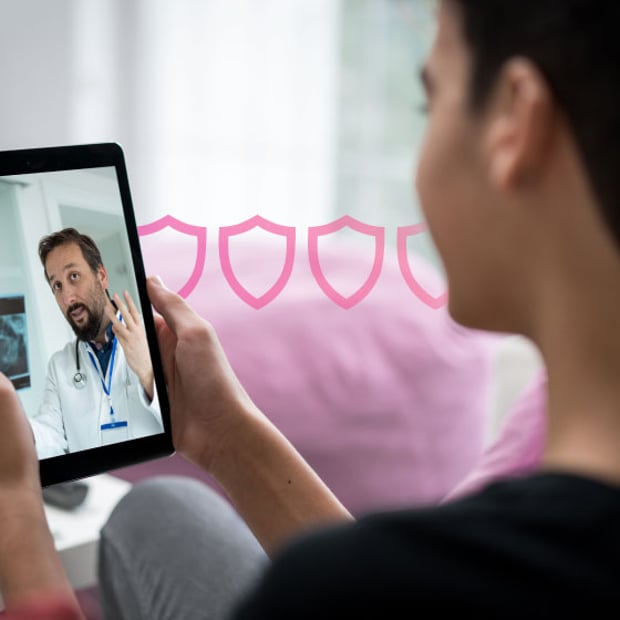Seeking HIPAA Compliance With Video? Here's What You Need to Know
If you’re part of the healthcare world, you know it’s absolutely essential to avoid HIPAA violations. In this article, we’ll take a close look at the video-focused healthcare arena, with an eye to HIPAA rules and requirements and with an emphasis on real-world use cases that let providers grow without tech limitations getting in the way.

HIPAA Compliance and Popular Technologies
The Healthcare Insurance Portability and Accountability Act (HIPAA) was enacted in 1996. In the years since, the impact of HIPAA on new technology solutions can't be overstated, from telemetry to smart device-based health apps and beyond. The act's comprehensive language and annual revisions make HIPAA compliance an ongoing balancing act rather than a one-and-done task for providers and other industry professionals.
Telehealth services, which require providers to store and transmit protected health information (PHI), naturally fall beneath the act's broad banner. According to the U.S. Department of Health and Human Services (HHS), to maintain ongoing HIPAA compliance and give patients the best virtual experiences possible, businesses providing telehealth services must take great care to ensure all of their communications tools honor PHI usage rules. Even minor oversights from well-meaning actors can create costly and embarrassing issues and compromise patient trust.
Fortunately, modern advancements like APIs and unified communication suites make it easy for healthcare providers of all sizes to integrate fully HIPAA-compliant communications features, including video. This means that increasingly popular services like video consultation are within reach for essentially any healthcare business.
HIPAA Compliance in Post-Pandemic Healthcare
Video-based telehealth was already getting a lot of attention in the healthcare industry before the 2020 pandemic, but there's little doubt that COVID-19's emergence accelerated the model's growth. At that time, unprecedented patient volumes pushed the HHS to enact temporary, "telehealth discretion" rules, which allowed providers to use "any non-public facing remote communication product that is available to communicate with patients," per the HHS. This meant doctors could hold virtual visits using apps like Facebook Messenger or services such as FaceTime without fear of adverse action by the HHS. And providers weren't required to enter business associate agreements (BAAs) with tech vendors, which allowed smaller health organizations to more easily offer new telehealth services without added costs.
Although undoubtedly necessary in the early, highly uncertain days of the pandemic, the open nature of telehealth discretion also meant that patient data was handled in ways HIPAA typically prohibits — and most associated regulations had essentially reverted to standard enforcement by August 2023, according to the HHS.
Healthcare businesses were given time to discontinue noncompliant practices following the above HHS announcement, but it's fair to say the changeover was especially troublesome for small and midsized providers — many of which may have lacked the resources and technical infrastructure needed to achieve telehealth HIPAA compliance. For example, a small or midsize health provider that didn't engage in a BAA with their temporary telehealth provider may have found that the patient- or employee-facing videoconferencing tools they'd been using were no longer HIPAA compliant, leaving them in a pinch, with no immediately clear alternative to offer patients or employees who had come to rely on telehealth.
Telehealth HIPAA Compliance for Healthcare SMBs: A Primer
Many patients have come to accept telehealth as part of their ongoing healthcare regimen. It's safe to assume that telehealth's earning floor and potential will only go up from here, even as telehealth discretion phases out and standard enforcement once again becomes the norm. The model is currently a $142 billion business that analysts predict could be worth as much as $502 billion by 2030, according to Fortune Business Insights. For small and mid-size providers looking for options following the closure of telehealth discretion, the smart money is on finding solutions that allow the practice to quickly implement video-based services. And this generally means implementing one of two options: turnkey or API-based solutions.
Turnkey Solutions: Instant Access to Telehealth Tech
Smaller health organizations and those lacking the technical and human resources to build a bespoke solution may find particular value in turnkey solutions like Vonage Meetings, a HIPAA-compliant option that allows service providers to hit the ground running with their video telehealth offerings. By definition, turnkey solutions are extremely easy to set up and adopt, and scaling them up to meet increases in demand is as simple as inputting new numbers.
Turnkey solutions also offer easy integration with existing business and healthcare tools such as healthcare EHRs and feature-added capabilities like sending appointment reminders via SMS, making for an out-of-the-box entry point to HIPAA-compliant video telehealth services. Perhaps most appealing, these services come as part of comprehensive unified communications platforms, meaning the same app can meet all of a health business's communications needs, and employees and patients don't have a fragmented experience.
API-Based Solutions: HIPAA Compliance for Your Current IT Infrastructure
API-based solutions such as Vonage Video API also enable health organizations to achieve HIPAA compliance with video-based telehealth offerings. These solutions, while not HIPAA compliant in and of themselves, get built into a provider's current or upcoming suite of applications to attain compliance.
What's the upside of embedding video into established healthcare applications? It can make for a smoother patient experience, less disruption for employees (who don't need to be trained on new videoconferencing solutions), and consistent branding across the health business's entire suite of products. Patients who currently use an app or web-based service to schedule appointments, for instance, may be pleased to find they can use the same service and login info for virtual visits. Embedding video capability also makes it easier for the business to house its data, such as patient notes, in one place and to communicate with patients over multiple channels in a HIPAA-compliant SMS and video environment.
 Explore the infographic
Explore the infographic
HIPAA-Compliant Telehealth: Patient- and Organization-Facing Use Cases
HIPAA is primarily concerned with keeping PHI secure and puts few restrictions on the type of telehealth services a business can offer, provided its technology and agreements meet the act's standards. And providers have increasingly found innovative ways to embed HIPAA-compliant telehealth into their practices. While not a comprehensive list, following are several prominent examples.
· Care That Weathers Obstacles. From inclement weather to personal mobility challenges, a lack of reliable transportation, and a home address in a rural area, there are many reasons people might not be able to get their healthcare needs met if an in-person visit is the only option. Health organizations can use HIPAA-compliant telehealth offerings to meet people where they're at, which can lead to improved health outcomes for patients and more customers for the provider.
· Peak Usage Management. Covid is one (extreme) example of a recent event that has pushed healthcare providers to capacity. Once they've achieved HIPAA compliance with a viable video solution, organizations can use telehealth to quickly scale up their practice, whether the need is temporary or permanent. For example, a business partnering with a staffing organization could implement telehealth services to increase its available appointments while keeping staffing costs at an acceptable level.
· Talk Therapy and Psychiatry. Many mental health-focused practices don't require in-person practitioner-client interactions in order for the practitioner to offer diagnosis or other support — so it's easy to see why many talk therapists and psychiatrists have embraced video telehealth to expand their services without impacting quality of care.
· Crisis Intervention. Telehealth also shows great promise in crisis intervention. Instead of requiring people in crisis to travel to receive support (something they may be unable to do), essentially all care recipients need is a phone, tablet, or computer to check in with their support team, which may improve outcomes.
· Physical Therapy. One of the most physically active forms of healthcare, physical therapy, can in some cases work just as well virtually as in person. Physical therapists and other providers can often perform functional movement screens easily in the virtual space.
· Post-Discharge Screenings. Following their discharge from in- or outpatient care, patients often prefer to continue improving at home if possible. And because it's important for practitioners to keep an eye on patients post-discharge, telehealth can work well in these situations. Additionally, allowing recovering patients (such as those recently discharged from surgery) to check in without traveling to a facility can mean fewer scheduling hold-ups, fewer missed appointments, and even reduced chances of further health complications.
· Medication Checks. In some cases, patients must visually confirm med counts to match physician expectations and continue their current care regimen. A provider may wish to check a patient's medication to ensure they aren't confused about usage, e.g., accidentally taking too much or too little. Telehealth allows providers to conduct medication checks virtually, which, again, can ease scheduling and saves patients from the hassle of having to travel to receive a qualified count.
· Chronic Disease Care. Conditions like hypertension and diabetes can create substantial disruptions in patients' lives if in-person visits are the only management option. Providing these patients with frequent care for chronic challenges can also fill up appointment slots and leave providers struggling to meet demands for their time. Used to enhance a regimen of in-person visits, periodic video-based telehealth offerings can reduce the pressure on both sides, improving quality of care and reducing provider workloads and costs.
· Prenatal and Postpartum Care. Having a baby is a major health event that requires major attention before and after delivery. When included as one part of a family's care plan, telehealth provides a convenient way for doctors and other providers (such as lactation consultants) and patients themselves to support the ongoing health of all involved. Telehealth can also be a boon for new parents who may not be sure whether an issue regarding their baby calls for an in-person visit.
· Real-Time Colleague Support. In fields such as radiology, more experienced practitioners often play wingman to colleagues who may be less experienced or specialized in different areas. Traditionally, this practice has required in-person presence, potentially straining business financially and from a scheduling perspective. Telehealth services allow the more experienced colleagues in these partnerships to check in with trainees and actively monitor health interactions. This capability can also be of huge value in intensive care settings, where more experienced practitioners oversee groups of busy colleagues.
· Eldercare. Older patients make up the largest percentage of healthcare recipients in the U.S. and beyond — and their unique circumstances may make it hard to manage a large number of in-person office visits. Telehealth's eldercare applications are already well-established, with many providers in the space incorporating these service options.
· Teledermatology. Dermatology is in high demand, and the field's staffing shortage — some experts say there are only 3.4 dermatologists per 100,000 patients in the U.S. — remains an issue. As a pre-visit option or simply as a way for providers to see more patients, teledermatology is another compelling use case for video-based telehealth services, and one that should only grow more valuable as the population ages.
Remember: Compliance, Not Complication
HIPAA compliance is a front-and-center concern among healthcare providers, with every new technology a practice implements coming with unique considerations and processes. But with the right support in place, adding video capabilities to a practice doesn't have to be complicated or even difficult. Turnkey solutions and API-based advancements greatly simplify the process of bringing video to patients and providers — and as more businesses see firsthand the value of these HIPAA-compliant solutions, expect both to have an increasing impact in the field of tech-forward healthcare.
Visit vonage.com/solutions/healthcare to learn more about how Vonage can help your healthcare practice with HIPAA compliant video.